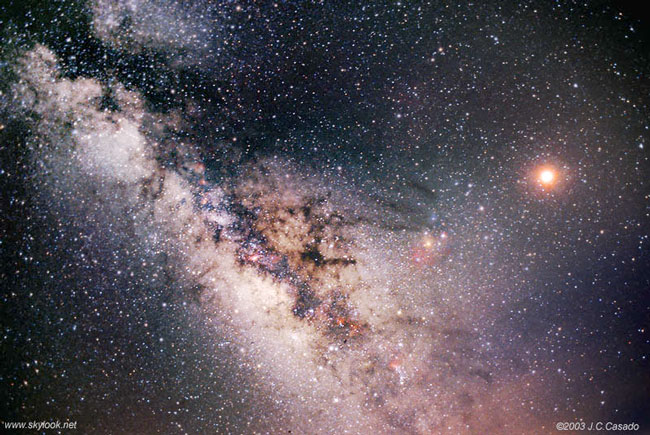Credit & Copyright: Juan Carlos Casado
Explanation:
What's behind the Moon? Each month,
our Moon passes in front of --
and outshines -- many an interesting star field.
Exceptions occur during a
new Moon and during a
total eclipse.
In the background of a new
Moon
is usually the Sun, an even brighter orb that even
more easily outshines everything behind it, except during a
total solar eclipse.
Even the longest total solar eclipse
lasts just a few minutes, while the
Sun's corona still remains bright.
During a total lunar eclipse,
however, the full Moon
dims and a majestic star field may present itself for an hour or more.
Such was the case during the middle of last month,
when a rare glimpse of an eclipsed Moon superposed in front of the disk of our home
Milky Way Galaxy was captured.
Although fully in the Earth's shadow, the eclipsed Moon is still the
brightest object on the right.
The above image was captured during sub-zero weather from the
Teide 2003 expedition to
Mirador del Pico Viejo, a mountain in the
Canary Islands,
Spain, off the northwest coast of
Africa.
1999 2000 2001 2002 2003 2004 2005 2006 2007 2008 2009 2010 2011 2012 2013 2014 2015 2016 2017 2018 2019 2020 2021 2022 2023 2024 2025 |
Yanvar' Fevral' Mart Aprel' Mai Iyun' Iyul' Avgust Sentyabr' Oktyabr' Noyabr' Dekabr' |
NASA Web Site Statements, Warnings, and Disclaimers
NASA Official: Jay Norris. Specific rights apply.
A service of: LHEA at NASA / GSFC
& Michigan Tech. U.
|
Publikacii s klyuchevymi slovami:
eclipse - Moon - Milky Way - zatmenie - Luna - Mlechnyi Put'
Publikacii so slovami: eclipse - Moon - Milky Way - zatmenie - Luna - Mlechnyi Put' | |
Sm. takzhe:
Vse publikacii na tu zhe temu >> | |
